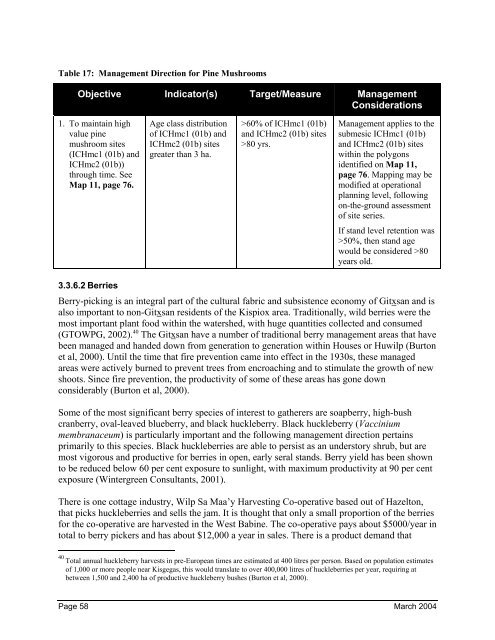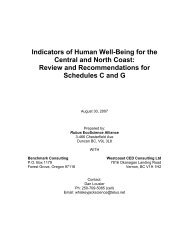West Babine Sustainable Resource Management Plan
West Babine Sustainable Resource Management Plan
West Babine Sustainable Resource Management Plan
Create successful ePaper yourself
Turn your PDF publications into a flip-book with our unique Google optimized e-Paper software.
Table 17: <strong>Management</strong> Direction for Pine Mushrooms<br />
Objective Indicator(s) Target/Measure <strong>Management</strong><br />
Considerations<br />
1. To maintain high<br />
value pine<br />
mushroom sites<br />
(ICHmc1 (01b) and<br />
ICHmc2 (01b))<br />
through time. See<br />
Map 11, page 76.<br />
3.3.6.2 Berries<br />
Age class distribution<br />
of ICHmc1 (01b) and<br />
ICHmc2 (01b) sites<br />
greater than 3 ha.<br />
>60% of ICHmc1 (01b)<br />
and ICHmc2 (01b) sites<br />
>80 yrs.<br />
<strong>Management</strong> applies to the<br />
submesic ICHmc1 (01b)<br />
and ICHmc2 (01b) sites<br />
within the polygons<br />
identified on Map 11,<br />
page 76. Mapping may be<br />
modified at operational<br />
planning level, following<br />
on-the-ground assessment<br />
of site series.<br />
If stand level retention was<br />
>50%, then stand age<br />
would be considered >80<br />
years old.<br />
Berry-picking is an integral part of the cultural fabric and subsistence economy of Gitxsan and is<br />
also important to non-Gitxsan residents of the Kispiox area. Traditionally, wild berries were the<br />
most important plant food within the watershed, with huge quantities collected and consumed<br />
(GTOWPG, 2002). 40 The Gitxsan have a number of traditional berry management areas that have<br />
been managed and handed down from generation to generation within Houses or Huwilp (Burton<br />
et al, 2000). Until the time that fire prevention came into effect in the 1930s, these managed<br />
areas were actively burned to prevent trees from encroaching and to stimulate the growth of new<br />
shoots. Since fire prevention, the productivity of some of these areas has gone down<br />
considerably (Burton et al, 2000).<br />
Some of the most significant berry species of interest to gatherers are soapberry, high-bush<br />
cranberry, oval-leaved blueberry, and black huckleberry. Black huckleberry (Vaccinium<br />
membranaceum) is particularly important and the following management direction pertains<br />
primarily to this species. Black huckleberries are able to persist as an understory shrub, but are<br />
most vigorous and productive for berries in open, early seral stands. Berry yield has been shown<br />
to be reduced below 60 per cent exposure to sunlight, with maximum productivity at 90 per cent<br />
exposure (Wintergreen Consultants, 2001).<br />
There is one cottage industry, Wilp Sa Maa’y Harvesting Co-operative based out of Hazelton,<br />
that picks huckleberries and sells the jam. It is thought that only a small proportion of the berries<br />
for the co-operative are harvested in the <strong>West</strong> <strong>Babine</strong>. The co-operative pays about $5000/year in<br />
total to berry pickers and has about $12,000 a year in sales. There is a product demand that<br />
40 Total annual huckleberry harvests in pre-European times are estimated at 400 litres per person. Based on population estimates<br />
of 1,000 or more people near Kisgegas, this would translate to over 400,000 litres of huckleberries per year, requiring at<br />
between 1,500 and 2,400 ha of productive huckleberry bushes (Burton et al, 2000).<br />
Page 58 March 2004

















